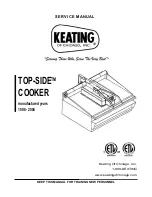
en
How it works
24
Fault
Cause and troubleshooting
appears after a
few seconds.
The external vacuum-sealing connection is not positioned correctly on the vacuum-sealing
compartment's air outlet.
▶
Check the position of the vacuum-sealing lid.
appears after the
pump has been run-
ning for two minutes.
As the temperature rises, liquids begin to boil, meaning that the vacuum cannot be formed.
1.
Only vacuum-seal cold liquids.
2.
If the vacuum-sealing compartment is wet, wipe it dry.
3.
Heat-seal the vacuum-sealing bag early if larger bubbles form.
4.
Select a lower vacuum-sealing level.
and light up
after the drying pro-
cess.
One drying process alone was not sufficient.
1.
Wait until no longer lights up.
2.
Repeat the drying process.
→
"Starting the drying", Page 21
12 How it works
Here, you can find the ideal settings for various dishes
as well as the best accessories and cookware. We
have tailored these recommendations to your appli-
ance.
12.1 Vacuum-sealing for sous-vide cooking
You can use your vacuum-sealing drawer to prepare
food for sous-vide cooking. Sous-vide cooking is a
method of cooking "under a vacuum" at low temperat-
ures between 50–95 °C and in 100% steam or in a
bain marie.
The vacuum-sealing drawer is used to heat-seal the
food in a special air-tight, heat-resistant cooking bag.
WARNING ‒ Risk of harm to health!
Sous-vide cooking is a method of cooking at low tem-
peratures and, if the instructions for use and hygiene
instructions are not adhered to, it may result adverse
health effects.
▶
Only use high-quality, perfectly fresh food.
▶
Wash and disinfect your hands.
▶
Use disposable gloves, cooking tongs or grill tongs.
▶
Take extra care when preparing critical food, such
as poultry, eggs and fish.
▶
Always thoroughly rinse and peel fruit and veget-
ables.
▶
Always keep work surfaces and chopping boards
clean.
▶
Use different chopping boards for different types of
food.
▶
Only interrupt the cold chain briefly to prepare the
food.
▶
Store vacuum-sealed food in the refrigerator before
you starting the cooking process.
▶
Once the food is cooked, consume it immediately.
Do not store it after cooking – not even in the refri-
gerator. It is not suitable for reheating.
Notes
¡
Use the enclosed vacuum-sealing bags for sous-
vide cooking. You can reorder the vacuum-sealing
bags.
¡
Do not cook the food in the bag in which you
bought it (e.g. portions of fish). These bags are not
suitable for sous-vide cooking.
¡
Position the items of food in the bag next to each
other and not on top of each other.
Vacuum-sealing for sous-vide cooking
1.
In order to achieve an even heat transfer and there-
fore a perfect cooking result, use the highest va-
cuum-sealing level to vacuum-seal food.
2.
Before cooking the food, check whether the vacuum
in the bag is intact. To do this, refer to these points:
– There is no air in the vacuum-sealing bag.
– The heat-sealed seam is perfectly sealed.
– There are no holes in the vacuum-sealing bag.
Do not use a core temperature probe.
– Pieces of meat or fish that have been vacuum-
sealed together are not pressed directly against
one another.
– Vegetables and desserts are vacuum-sealed flat.
3.
If the vacuum-sealing bag is not filled ideally, place
the food into a new bag and vacuum-seal it again.
Note:
To prevent gases escaping from the food, e. g.
from vegetables, vacuum-seal the food no more than
one day before the cooking process. The gases pre-
vent the transfer of heat or cause the texture of the
food to change, thus altering how it cooks, as a result
of the vacuum pressure.
12.2 Vacuum-sealing glass bottles
You can also use the vacuum-sealing drawer to va-
cuum and reseal glass bottles, e.g. bottles of cooking
oil.
1.
Fit the air outlet on the vacuum-sealing adapter in
such a way that the outlet for the hose is facing up-
wards vertically.
2.
Secure the bottle cap to the bottle opening.
3.
Press the bottle adapter onto the bottle cap.
Summary of Contents for DVP 221
Page 27: ......





































